
Baeckea is a genus of flowering plants in the myrtle family, Myrtaceae, all but one endemic to Australia. Plants in the genus Baeckea are shrubs or small trees with leaves arranged in opposite pairs, white to deep pink flowers with five sepals and five petals, and five to fifteen stamens that are shorter than the petals.

Melaleuca armillaris, commonly known as bracelet honey myrtle, is a plant in the myrtle family, Myrtaceae, and is native to South Australia, Victoria and Tasmania in south-eastern Australia. It is a hardy, commonly grown species, often used as a fast-growing screen plant, but it also has the potential to become a weed. It has become naturalised in Western Australia and parts of Victoria. In its natural state, it grows on coastal cliffs and along estuaries.

Leptospermum laevigatum, commonly known as the coast tea tree, is a species of shrub or small tree that is endemic to south-eastern Australia, but has been widely introduced in other places where it is often considered to be a weed. It has thin, rough bark on the older stems, narrow egg-shaped leaves, relatively large white flowers and flat topped fruit that is shed shortly after reaching maturity.

Corymbia gummifera, commonly known as red bloodwood, is a species of tree, rarely a mallee, that is endemic to eastern Australia. It has rough, tessellated bark on the trunk and branches, lance-shaped adult leaves, flower buds in groups of seven, creamy white flowers and urn-shaped fruit.

Melaleuca viminalis, commonly known as weeping bottlebrush or creek bottlebrush, is a plant in the myrtle family Myrtaceae, and is endemic to New South Wales, Queensland and Western Australia. It is a multi-trunked, large shrub or tree with hard bark, often pendulous foliage and large numbers of bright red bottlebrush flowers in spring and summer. It is possibly the most commonly cultivated melaleuca in gardens and its cultivars are often grown in many countries.

Melaleuca viridiflora, commonly known as broad-leaved paperbark, is a plant in the myrtle family Myrtaceae, and is native to woodlands, swamps and streams in monsoonal areas of northern Australia and New Guinea. It is usually a small tree with an open canopy, papery bark and spikes of cream, yellow, green or red flowers.

Leptospermum squarrosum, commonly known as the peach blossom tea-tree, is an upright shrub of the family Myrtaceae and is endemic to central eastern New South Wales. It has thin, firm bark, broadly lance-shaped to elliptical leaves, relatively large white or pink flowers and fruit that remain on the plant when mature.

Conospermum taxifolium, commonly known as variable smoke-bush, yew-leaf smoke bush or paint brush, is a plant in the family Proteaceae and is endemic to eastern Australia. It is an erect shrub with narrow elliptic to narrow egg-shaped leaves with the narrower end towards the base and panicles of cream-coloured to white, tube-shaped flowers.

Baeckea brevifolia is a species of flowering plant in the family Myrtaceae and is endemic to south-eastern New South Wales. It is a shrub with narrow egg-shaped to oblong leaves and white to pink flowers with nine to fifteen stamens.

Melaleuca nodosa, commonly known as the prickly-leaved paperbark, is a plant in the myrtle family Myrtaceae, and is endemic to eastern Australia. It is a shrub or small tree with narrow, sometimes needle-like leaves and profuse heads of yellow flowers as early as April or as late as January.
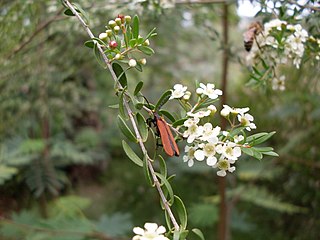
Sannantha pluriflora, commonly known as tall baeckea, is a species of flowering plant in the myrtle family, Myrtaceae, and is endemic to continental southeastern Australia. It is a shrub or small tree with lance-shaped to elliptic leaves, and groups of two to nine white flowers arranged in umbels in leaf axils.
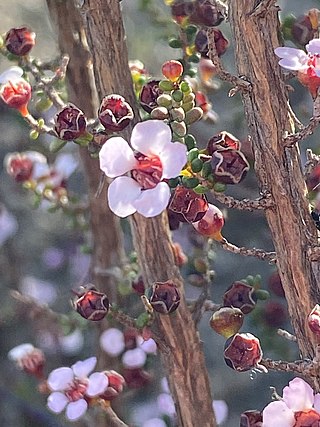
Rinzia orientalis, commonly known as desert heath-myrtle, is a species of flowering plant in the family Myrtaceae and is endemic to south-eastern Australia. It is a shrub with elliptic to narrowly oblong leaves and white or pale pink flowers usually with ten stamens.

Kunzea phylicoides, commonly known as the slender burgan, is a flowering plant in the myrtle family, Myrtaceae and is endemic to south-eastern Australia. It is an erect shrub with drooping branches, fibrous or corky bark, bright green, narrow leaves and clusters of white flowers in spring.

Leptospermum arachnoides, commonly known as the spidery tea-tree, is a species of shrub that is endemic to eastern Australia. It has rough bark, crowded linear to lance-shaped leaves with a sharp point on the end, white flowers and hairy fruit.
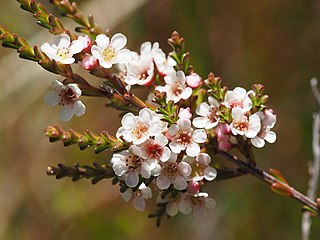
Baeckea omissa is a species of flowering plant in the family Myrtaceae and is endemic to eastern Australia. It is a shrub with egg-shaped to lance-shaped leaves with the narrower end towards the base and white flowers mostly with ten to fifteen stamens.
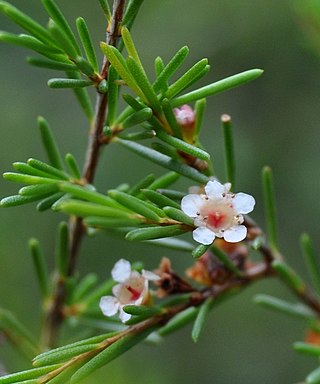
Baeckea frutescens is a species of flowering plant in the family Myrtaceae and is native to eastern Southeast Asia, New Guinea and Australia. It is a shrub with arching branches, linear leaves and white flowers with seven to thirteen stamens.
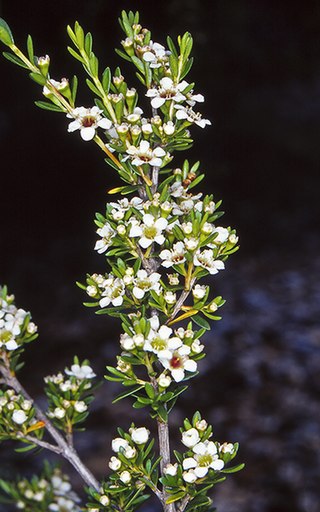
Baeckea latifolia is a species of flowering plant in the family Myrtaceae and is endemic to south-eastern continental Australia. It is a shrub with broadly elliptic leaves and small white flowers with six to eight stamens.

Baeckea leptocaulis is a species of flowering plant in the family Myrtaceae and is endemic to Tasmania. It is a shrub with linear leaves and small white flowers with five or six stamens.
Baeckea trapeza is a species of flowering plant in the family Myrtaceae and is endemic to Queensland. It is a shrub with lance-shaped leaves with the narrower end towards the base, and white flowers with eight to eleven stamens.

Baeckea utilis, commonly known as mountain baeckea, is a species of flowering plant in the family Myrtaceae and is endemic to south-eastern continental Australia. It is a shrub with elliptic to lance-shaped leaves with the narrower end towards the base and white flowers, usually with eight stamens.



















